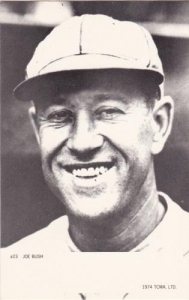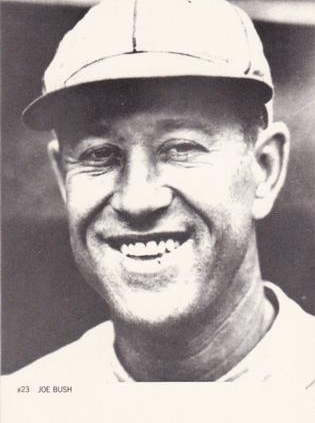August 26, 1916: Bullet Joe Bush fires no-hitter for A’s
 “Such a brand of revenge was never seen before,” gushed sportswriter Harry P. Edwards in the Cleveland Plain Dealer.1 In the game after getting knocked out of the box, yielding six hits and five runs (though just two earned) in a three-inning start resulting in his 20th loss of the season, Philadelphia Athletics right-hander Bullet Joe Bush held the Cleveland Indians hitless, retiring the final 27 batters he faced.
“Such a brand of revenge was never seen before,” gushed sportswriter Harry P. Edwards in the Cleveland Plain Dealer.1 In the game after getting knocked out of the box, yielding six hits and five runs (though just two earned) in a three-inning start resulting in his 20th loss of the season, Philadelphia Athletics right-hander Bullet Joe Bush held the Cleveland Indians hitless, retiring the final 27 batters he faced.
Athletics owner-manager Connie Mack had little to be excited about in 1916. The days of winning four pennants and three World Series titles in a five-year span (1910-1914) seemed like an eternity ago. Rapidly rising player salaries and lower revenues forced the Tall Tactician to sell his star players, among them Eddie Collins and Home Run Baker, and had lost others to the upstart Federal League, like hurlers Chief Bender and Eddie Plank. The A’s plummeted to the worst record (43-109) in the big leagues in 1915 and it was even more dismal thus far in 1916 as they prepared to play the final contest of a four-game series against the Indians. Mack’s club once again had the worst slate (25-91) in the majors and had endured an unimaginably futile 4-56 stretch. Indians skipper Lee Fohl had transformed the Tribe from a seventh-place team in ’15 into a pennant contender, who trailed the front-running Boston Red Sox by 6½ games.
One of the few bright spots for Mack was 23-year-old “speed demon hurler” Joe Bush.2 The 5-foot-9, 175-pound Minnesotan debuted for the Mackmen as a teenager in 1912, and produced a 15-6 slate as a swingman for the world champions the next season, a role he occupied again for the pennant winners in 1914, going 17-13. Lauded by the Philadelphia Inquirer for his “great curve and blinding speed,” Bush was emerging as one of the most effective and durable hurlers in the junior circuit, despite his 13-20 record thus far in ’16, ranking third in complete games (21 in 27 starts) and fourth in strikeouts (128).3 His mound opponent was 26-year-old right-hander Stan Coveleski (14-10), who had had a cup of coffee with the A’s in 1912 but was now with the Indians in his first full season.
The demise of the Athletics dynasty was followed by an implosion of attendance at Shibe Park, the steel-and-concrete ballpark that opened in 1909. The A’s averaged only 2,427 spectators per contest in 1916, the second lowest figure in the majors. Attendance for this game isn’t available; however, given that it was a Saturday afternoon game on a warm, late summer afternoon when Sunday baseball in the City of Brotherly Love was still banned, those who did venture out to the north side of the city witnessed a historical game.
If only he could have taken back one pitch. No doubt Bush must have had such thoughts after this game, maybe for the rest of his life. He walked the first batter of the game, Jack Graney, and then proceeded to retire the next 27 batters. The first was Terry Turner, whose sacrifice moved Graney up a station. The Indians were a “meek and lowly lot” thereafter, gushed the Inquirer.4 Edwards wrote admiringly that “Bush simply had everything, control, speed and curves” and added that his “change of pace was amazing. The break of his fastball was marvelous.”5 The Inquirer likewise extolled Bush’s “bewildering change-of-pace,” which the paper opined “stood Lee Fohl’s hard-hitting bunch on their heads.”6
Bush did not yield the semblance of a hit. The Plain Dealer noted that “not even a close decision” nor “a brilliant play had to be made.”7 The only tense moment occurred in the fifth inning when catcher Val Picinich grabbed Chick Gandil’s bunt in front of home plate but “threw wild” to first, erasing the runner “by a fraction of a stride,” according to the Inquirer.8 Just 19 years old, Picinich was one month removed from playing semipro ball and was making only his 15th big-league start as a catcher.
Coveleski, who eventually went on to a Hall of Fame career, winning 20 or more games five times and posting 215 lifetime victories, had a tough day and was plagued by some shoddy defense. In the second inning, Wally Schang hit a fly ball to right-center field, which right fielder Braggo Roth should have caught; however, he thought center fielder Tris Speaker would take the ball, and suddenly stopped.9 The ball dropped between the two flychasers and Schang raced to third. Two batters later, Stuffy McInnis “skimmed a roller between” shortstop Bill Wambsganss’ feet to drive in the game’s first run.10
The Athletics loaded the bases with no outs in the next frame, yet came away with just a solitary run. After Jimmy Walsh led off with a single and was forced by Amos Strunk, Schang connected on what the Plain Dealer described as a “freak hit,” a tailor-made double-play bouncer back to the mound, but the ball “took a peculiar bound” and Coveleski had no play at either first or second.11 Nap Lajoie’s free pass filled the bags and then McInnis squeezed home Strunk on a bunt to first.
Coveleski came undone in the fifth, yielding three straight extra-base knocks. Picinich led off with a double and moved to third on a passed ball. Bush, who eventually transformed into an adept hitter, batting .253 in his career, belted an RBI double. Whitey Witt followed with a triple to plate Bush, and subsequently scored on Walsh’s sacrifice bunt to make it 5-0. Fritz Coumbe replaced Coveleski to start the sixth and hurled three frames of scoreless relief.
Bush took the mound in the ninth three outs from his first no-hitter and the third in franchise history. Weldon Henley tossed the first, on July 22, 1905, against the St. Louis Browns, at League Park, where the Athletics played before Shibe Park opened in 1909. Chief Bender tossed the second (and first in Shibe Park), on May 12, 1910, against the Cleveland Naps. With heightened excitement, and undoubtedly adrenaline-induced nervousness, Bush had a three-ball count on the first two hitters, Steve O’Neill and Bob Coleman, pinch-hitting for Coumbe, before striking each out. Bush completed his no-no by inducing Graney, the Indians’ only baserunner of the game, to up to McInnis at first to end the game in 1 hour and 39 minutes.12
As the final out was recorded, an estimated 500 fans poured onto the field to congratulate the young hurler, who, newspapers noted entered “baseball’s mythical Hall of Fame,” a much-used euphemism for monumental accomplishments, such as a no-hitter.13 Hundreds of fans were still waiting at the park to catch a glimpse of Bush as he went home.
In a commanding effort, Bush fanned seven and induced 12 popups (eight of those to the outfield) and eight grounders. Nonetheless, Bush’s no-hitter couldn’t disguise the fact that the A’s were a terrible ballclub en route to arguably the worst season in post-1900 big-league history, finishing with a 36-117 record and (as of 2021) a major-league record-low .235 winning percentage. Bush struggled, too, after his gem, losing his next four starts, plagued by wildness (16 earned runs and 20 walks in 31⅓ innings) before tossing his eighth shutout in his final start of the season to finish with 15 wins and a big-league-most 24 losses. Bush went on to win 196 games in his career (184 losses), including 26 victories for the pennant-winning New York Yankees in 1922, and played on three World Series champions (Athletics in 1913, Boston Red Sox in 1918, and Yankees in 1923). He never threw another no-hitter, though he hurled three one-hit shutouts.
SOURCES
In addition to the sources cited in the Notes, the author accessed Retrosheet.org, Baseball-Reference.com, SABR.org, and The Sporting News archive via Paper of Record.
NOTES
1 Henry P. Edwards, “Indians Blanked When Joe Bush Pitches No-Hit Game for Mackmen,” (Cleveland) Plain Dealer, August 27, 1916: III, 1.
2 Edwards.
3 “Bush Ascends to No-Hit Pedestal,” Philadelphia Inquirer, August 27, 1916: 53.
4 “Bush Ascends to No-Hit Pedestal.”
5 Edwards.
6 “Bush Ascends to No-Hit Pedestal.”
7 Edwards.
8 “Bush Ascends to No-Hit Pedestal.”
9 Edwards.
10 Edwards.
11 Edwards.
12 Game time from “Bush Ascends to No-Hit Pedestal.”
13 “Bush Ascends to No-Hit Pedestal.”
Additional Stats
Philadelphia Athletics 5
Cleveland Indians 0
Shibe Park
Philadelphia, PA
Box Score + PBP:
Corrections? Additions?
If you can help us improve this game story, contact us.


